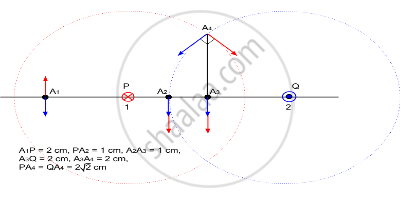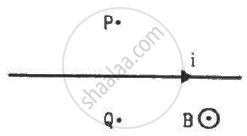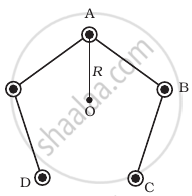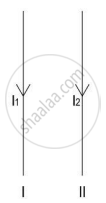Advertisements
Advertisements
प्रश्न
Figure shows two parallel wires separated by a distance of 4.0 cm and carrying equal currents of 10 A along opposite directions. Find the magnitude of the magnetic field B at the points A1, A2, A3.

उत्तर
For point A1,
Magnitude of current in wires, I = 10 A
Separation of point A1 from the wire on the left side, d = 2 cm
Separation of point A1 from the wire on the right side, d' = 6 cm

In the figure
Red and blue arrow denotes the direction of magnetic field due to the wire marked as red and blue respectively.
P (marked red) denotes the wire carrying current in a plane going into the paper.
Q (marked blue) denotes the wire carrying current in a plane coming out of the paper.
Also from the figure, we can see that
\[P A_4 = Q A_4 \]
\[\angle A_4 A_3 P = \angle A_4 A_3 Q = 90^\circ \]
\[ \Rightarrow \angle A_4 P A_3 = \angle A_4 Q A_3 = 45^\circ \]
\[ \Rightarrow \angle P A_4 A_3 = \angle Q A_4 A_3 = 45^\circ \]
\[ \Rightarrow \angle P A_4 Q = 90^\circ \]
The magnetic field at A1 due to current in the wires is given by
\[B = \frac{\mu_0 I}{2\pi d} - \frac{\mu_0 I}{2\pi d'}\] ...(1)
\[\Rightarrow B = \frac{2 \times {10}^{- 7} \times 10}{2 \times {10}^{- 2}} - \frac{2 \times {10}^{- 7} \times 10}{6 \times {10}^{- 2}}\]
\[ = \left( 1 - \frac{1}{3} \right) \times {10}^{- 4} \]
\[ = 0 . 67 \times {10}^{- 4} T\]
Similarly, we get the magnetic field at A2 using eq. (1).
\[B = \frac{2 \times {10}^{- 7} \times 10}{1 \times {10}^{- 2}} + \frac{2 \times {10}^{- 7} \times 10}{3 \times {10}^{- 2}}\]
\[ = \frac{8}{3} \times {10}^{- 4} T\]
\[ = 2 . 67 \times {10}^{- 4} T\]
Now,
Magnetic field at A3:
\[B = \frac{2 \times {10}^{- 7} \times 10}{2 \times {10}^{- 2}} + \frac{2 \times {10}^{- 7} \times 10}{2 \times {10}^{- 2}}\]
\[ = 2 \times {10}^{- 4} T\]
Separation of point A4 from the wire on the left side, d = \[\sqrt{2^2 + 2^2} = 2\sqrt{2} \] cm
\[B = \sqrt{\left( \frac{2 \times {10}^{- 7} \times 10}{2\sqrt{2} \times {10}^{- 2}} \right)^2 + \left( \frac{2 \times {10}^{- 7} \times 10}{2\sqrt{2} \times {10}^{- 2}} \right)^2}\]
\[ = 1 \times {10}^{- 4} T\]
APPEARS IN
संबंधित प्रश्न
The figure shows three infinitely long straight parallel current carrying conductors. Find the
(i) magnitude and direction of the net magnetic field at point A lying on conductor 1,
(ii) magnetic force on conductor 2.

Two long straight parallel conductors 'a' and 'b', carrying steady currents Ia and Ib are separated by a distance d. Write the magnitude and direction of the magnetic field produced by the conductor 'a' at the points along the conductor 'b'. If the currents are flowing in the same direction, what is the nature and magnitude of the force between the two conductors?
and ```vecE` and `vecB`denote electric and magnetic fields in a frame S and `vecE`→ and `vecB` in another frame S' moving with respect to S at a velocity `vecV` Two of the following equations are wrong. Identify them.
(a) `B_y^, = B_y + (vE_z)/c^2`
(b) `E_y^' = E_y - (vB_z)/(c^2)`
`(c) Ey = By + vE_z`
`(d) E_y = E_y + vB_z`
Two parallel, long wires carry currents i1 and i2 with i1 > i2. When the currents are in the same direction, the magnetic field at a point midway between the wires is 10 µT. If the direction of i2 is reversed, the field becomes 30 µT. The ratio i1/i2 is
A long, straight wire of radius R carries a current distributed uniformly over its cross section. T he magnitude of the magnetic field is
(a) maximum at the axis of the wire
(b) minimum at the axis of the wire
(c) maximum at the surface of the wire
(d) minimum at the surface of the wire.
A long, straight wire carrying a current of 1.0 A is placed horizontally in a uniform magnetic field B = 1.0 × 10−5 T pointing vertically upward figure. Find the magnitude of the resultant magnetic field at the points P and Q, both situated at a distance of 2.0 cm from the wire in the same horizontal plane.

A straight wire of length l can slide on two parallel plastic rails kept in a horizontal plane with a separation d. The coefficient of friction between the wire and the rails is µ. If the wire carries a current i, what minimum magnetic field should exist in the space in order to slide the wire on the rails?
The magnetic field existing in a region is given by `vecB = B_0(1 + x/1)veck` . A square loop of edge l and carrying a current i, is placed with its edges parallel to the x−y axes. Find the magnitude of the net magnetic force experienced by the loop.
A rectangular coil of 100 turns has length 5 cm and width 4 cm. It is placed with its plane parallel to a uniform magnetic field and a current of 2 A is sent through the coil. Find the magnitude of the magnetic field B if the torque acting on the coil is 0.2 N m−1
Consider a 10-cm long piece of a wire which carries a current of 10 A. Find the magnitude of the magnetic field due to the piece at a point which makes an equilateral triangle with the ends of the piece.
A long, straight wire carries a current i. Let B1 be the magnetic field at a point P at a distance d from the wire. Consider a section of length l of this wire such that the point P lies on a perpendicular bisector of the section B2 be the magnetic field at this point due to this second only. Find the value of d/l so that B2 differs from B1 by 1%.
Three coplanar parallel wires, each carrying a current of 10 A along the same direction, are placed with a separation 5.0 cm between the consecutive ones. Find the magnitude of the magnetic force per unit length acting on the wires.
Answer the following question.
Two infinitely long straight wire A1 and A2 carrying currents I and 2I flowing in the same direction are kept' distance apart. Where should a third straight wire A3 carrying current 1.5 I be placed between A1 and A2 so that it experiences no net force due to A1 and A2? Does the net force acting on A3 depend on the current flowing through it?
Three infinitely long parallel straight current-carrying wires A, B and C are kept at equal distance from each other as shown in the figure. The wire C experiences net force F. The net force on wire C, when the current in wire A is reversed will be ______.

Five long wires A, B, C, D and E, each carrying current I are arranged to form edges of a pentagonal prism as shown in figure. Each carries current out of the plane of paper.

- What will be magnetic induction at a point on the axis O? AxisE is at a distance R from each wire.
- What will be the field if current in one of the wires (say A) is switched off?
- What if current in one of the wire (say) A is reversed?
Beams of electrons and protons move parallel to each other in the same direction. They ______.
The figure below are two long, parallel wires carrying current in the same direction such that I1 < I2.

- In which direction will wire I1 move?
- If the direction of the current I2 is reversed, in which direction will the wire I1 move now?
